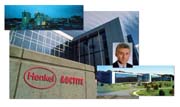Leading the Pack

ASI: How long have you been with Henkel? What changes have you seen in the adhesives industry overall and in Henkel specifically? How have these changes affected the way that Henkel does business?
JF: I have worked for Henkel for 30 years. Over the last decade, we have seen tremendous consolidation in the adhesives industry. Our market was once made up of many small- to medium-sized companies and a few large manufacturers. Many of the midsize players are now disappearing, having been acquired by large companies. And the bigger the Goliaths get, the more global the industry becomes. Major adhesive brands are no longer sold locally. Most are now available anywhere in the world.
Henkel has been at the front end of both of these trends. Since the late 1990s, we have been selectively acquiring new companies. For example, since 1997, in North America we have acquired Loctite Corp., the specialty polymers business of Dexter Corp., Multicore Solders and Resistol Corp., among others. The companies that we have purchased were already marketing their products globally. By making these acquisitions, we have significantly broadened our branded technology portfolio throughout the world.
ASI: When and how was Henkel formed?
JF: Fritz Henkel, a 28-year-old merchant who was interested in science, founded the company along with two partners in 1876 in Aachen, Germany. The company marketed its first product, "Universalwaschmittel," the world's first self-acting detergent based on silicate and perborate. This product catapulted a startup three-man business into a global group now represented in 75 countries. In its 127-year history, our family-owned company has experienced astonishing success selling home and personal care products, and adhesives, sealants, and surface treatments.
Henkel's industrial competence in adhesives and sealants grew out of the world economic crisis in the 1920s. Henkel's production of Persil laundry detergent became endangered because of external suppliers' inability to supply adhesives used in packaging the product. As adhesive supplies threatened to dry up, Henkel was forced to set up its own adhesive production to safeguard sales of Persil.
Once Henkel satisfied its own adhesive demand, the company began to supply adhesives to local firms. The first Henkel adhesive left the factory in Dusseldorf-Holthausen on June 22, 1923 - a historic day for the company, marking the beginning of an industrial success story that no one would have been able to predict at the time.
ASI: How was Loctite founded?
JF: The Loctite® brand began in 1953 in the laboratory of Dr. Vernon Krieble, an entrepreneurial chemistry professor who developed a cure inhibition system for a unique anaerobic sealant that hardened in the absence of air. The sealant promised to solve the age-old problem of loose nuts and bolts in machines and appliances - a problem that customers had long accepted as unsolvable.
This was the first in a series of technological innovations and breakthroughs for the company. At the time of the January 1997 acquisition of Loctite Corp. by Henkel KGaA, worldwide sales for Loctite Corp. exceeded US $800 million.
ASI: What is the business philosophy of Henkel?
JF: Henkel's business goal is to offer superior products that make people's lives easier, better and more beautiful. Truly customer-oriented, we are committed to innovation, excellence and quality. We make decisions based on long-term sustainability - while we want to be profitable for our shareholders today, we want to be in business another 127 years from today. We embrace change and social responsibility in order to ensure long-term success.
We are constantly working to preserve our tradition as an open family company. We recognize the overwhelming value of the people that make up Henkel and strive to communicate openly and actively with our employees and the public.
ASI: What is the key to Henkel's lead in adhesives and sealants sales?
JF: Today, Henkel is a leader in the global adhesives and sealants market. First and foremost, we are customer driven. We believe in building lasting relationships with our customers so that we can deliver real value through our products, service and support. We actively manage our portfolio of technologies and our market segments to ensure that we can offer a broad range of solutions to our customers' technological challenges.
Henkel is well positioned for growth. We manage our products and our businesses globally by strategically positioning our operations to effectively support customers around the world. By leveraging our market position from one region to another, we can also leverage key competencies such as technical service, marketing, sales and operations.
ASI: What other significant developments has Henkel made that have changed how/where/when adhesives and sealants are used?
JF: As a company, we invest a significant percentage of our annual revenue into new product development for both our consumer and industrial customers in an effort to deliver cutting edge technology and breakthrough solutions. On our customers' behalf, we proactively look for ways to produce higher quality products while reducing manufacturing costs.
Here's an example of a truly unique customer program designed to improve the way appliances are manufactured and to give our customers a competitive advantage. At the Henkel Innovation Center in Rocky Hill, CT, the latest appliance designs are dismantled in order to identify new ways to improve product quality and reduce costs. Appliance design, manufacturing and materials engineers partner with their counterparts from Henkel to get a full picture of manufacturing processes and cost reduction opportunities. The primary goal of any appliance teardown is to identify cost saving opportunities for the manufacturer. Cost savings may be recognized by eliminating inventoried parts, streamlining the overall production process or finding ways to automate steps that had required manual assembly.
This teardown program is identifying new applications everyday for adhesives and sealants in the appliance market. We are also applying the concept to many other industrial markets for our customers.
ASI: R&D is obviously a huge part of a company's success. The "Fritz Henkel Awards for Innovation" are given each year to employees - in 2003, an award was given for the development of anaerobic sticks. Can you talk more about these awards, and other efforts of the company to encourage research and development into new adhesive/sealant technologies?
JF: At Henkel, our culture recognizes the important contribution innovation makes to overall success. Each year, through the Fritz Henkel Awards for Innovation, our company recognizes several significant global innovations by honoring the individuals involved in their successful implementation. In 2003, one recipient was the Loctite® Thread Treatment Sticks product line, innovative and proprietary threadlocking, thread sealing, and anti-seize technology in semi-solid stick form. Patented worldwide, these products compliment existing liquid anaerobic technology and are the first chemical threadlocking and thread-sealing products in semi-solid form.
To encourage ongoing R&D, Henkel has established our "Voice of the Customer Sessions," a collaborative development program with key customers, particularly those in the appliance, medical, and agricultural/construction equipment industries. In these sessions, we interview key contacts about their current and future needs and goals in an effort to identify applications where our products may solve a problem. For example, the appliance industry wants to manufacture products that are quieter and more energy efficient, at lower cost. Knowing these goals in advance, Henkel can deliver any number of targeted solutions to meet all three objectives.
ASI: What is currently on the horizon as far as R&D is concerned?
JF: Hybrid technologies are currently our hottest area of new product development. These systems combine the best complimentary characteristics of two existing technologies into a new product offering. For example, in 1998 Henkel introduced light-curing cyanoacrylate technology, hybrid formulations that surface cure immediately when exposed to light, adapt easily into production lines and require no second-step accelerators or activators. Any adhesive located in shadowed areas or behind opaque substrates cures naturally and quickly at room temperature due to a secondary moisture-cure mechanism. Other hybrids are currently under development.
Also on the horizon for 2005 is an improved range of cyanoacrylates. Loctite popularized cyanoacrylates for the industrial market in the 1970s as ideal one-part, rapid-curing, room temperature adhesives. Next-generation products will be more robust and versatile for an even broader range of applications and substrates.
Currently entering commercialization in the surface treatment line for Henkel is an advanced nanoceramic surface coating that will dramatically increase the corrosion resistance of painted metal surfaces. The protection of Bonderite® NT-1 will exceed the results of a typical iron phosphate, non-chrome rinse process.
ASI: Please explain the Stage Gate Concept, and give an example of one commercial product's progression through each stage to commercialization.
JF: Stage GateTM is a market-driven new product development process that allows us to manage risk, increase ROI, and decrease time to market for a new product introduction. Work is completed in "stages" that follow quality control checkpoints called "gates." From each stage, a set of specific deliverables is produced for review and approval at the next gate. Once approved for economic and business viability, the project advances to the next stage.
A five-step Stage Gate process begins with a basic new business idea and a discovery process, followed by an initial idea screening. Stage Gate then involves the following stages: Stage 1: Scoping/Validation; Stage 2: Business Case Development; Stage 3: Product Development; Stage 4: Scale Up/Commercialization; and Stage 5: Product Launch. In between each stage, gatekeepers meet to review the idea and make sure that it is still on-strategy and viable.
Industrywide, one out of every seven product ideas goes to commercialization. Not all are successful. Henkel's historical results were very similar. Our company implemented Stage Gate 1) to improve the success rate of its new business development efforts, and 2) to decrease time to market for new product introductions. Henkel has been using Stage Gate to implement projects for the past two years.
Using Stage Gate, Henkel's Thread Treatment Stick new product launch improved its time to market by 30%. The Sticks concept of delivering liquid thread treatment products in a semi-solid stick form was validated by lab work that proved the semi-solid formulations could be made. Customer focus groups confirmed a market for the new technology.
Once the concept was validated for technical feasibility and market demand, the Sticks team moved into Stage 2, full-scale business case development. The team analyzed the technical plan for the product, the resources required and financial data related to both investment and return. They outlined milestone steps to product commercialization, defined the customer market and reached out to obtain customer input about the product idea. Finally, they developed a launch plan.
In product development, Stage 3, the team took the concept and converted it into an actual finished product, working out any technical, packaging, and performance challenges along the way. During Stage 4, the team coordinated the interface between R&D, pilot facilities, and manufacturing to produce the actual product and inventory it in Henkel warehouses. At this point, product marketing programs were also prepared for rollout.
Stage 5 was the actual launch of the Sticks products into the MRO and OEM markets. It took just nine months from presentation of the Sticks concept to actual commercialization, an extremely fast turnaround for a new product introduction. As the official launch of Loctite® Thread Treatment Sticks was global, worldwide capabilities had to be synchronized, which took another six month. The product was successfully launched in 2003 and is thriving today.
ASI: How is Henkel dealing with the increase in raw materials and feedstock prices?
JF: We are constantly monitoring changes in petroleum prices and their impact on feedstocks. As a large global organization, we can leverage our purchasing power to source materials at the best prices worldwide. It has long been a strict discipline at Henkel to continuously improve our sourcing, manufacturing and distribution processes to create the greatest possible value for our customers.
ASI: What do you see for the future of the adhesives and sealants industry? What changes are in store for formulators?
JF: In order to add true value for our customers, formulators need to invest more time developing products collaboratively with customers as opposed to focusing internally. Historically, adhesive companies have developed new technologies, then searched for real-world applications for their products. Today's formulators must identify needs and applications based on customer input by investigating customers' specific design issues, such as new substrates used, device recyclability, and other concerns. Then, our job is to deliver solutions. By doing so, we will enjoy unlimited opportunities to replace mechanical fastening technologies with superior adhesives and sealants.
ASI: What are your predictions for Henkel's future in the adhesives and sealants market?
JF: We at Henkel have been watching and learning from emerging trends in industrial manufacturing, such as the design issues listed in the previous question. Adhesives and sealants will be an enabling technology in the 21st century that will allow manufacturers to work with the latest substrates and materials to design and assemble their products.
Henkel will play a significant role in the future by providing the adhesive technologies of choice for manufacturing and assembly across industries. There is unlimited opportunity to grow in the adhesives and sealants market, and Henkel and its shareholders are committed to excelling in the market.
Looking for a reprint of this article?
From high-res PDFs to custom plaques, order your copy today!






